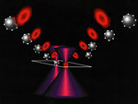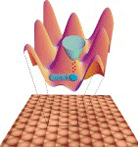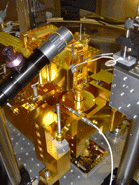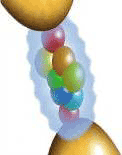CNST Nanotechnology Seminar Series - 2005
| FRIDAY |
DECEMBER 9, 2005, 2:30 PM - Bldg 215, Rm C103-C106 |
|
 ELECTRON TRANSPORT AT THE OUTER NANOMETER ELECTRON TRANSPORT AT THE OUTER NANOMETER
Ellen Williams
Director, Materials Research Science and Engineering Center, University of Maryland
The nanoscale world is not a scaled-down version of the macroscopic world. Nanoscale structures have special properties by virtue of their smallness alone, which yields quantum confinement, high surface-to-volume ratio and susceptibility to fluctuations. Direct imaging at the atomic scale using scanned probe techniques allows the latter effect, fluctuations, to be observed and quantified. Quantitative characterization of these fluctuations using the tools of statistical mechanics yields correlation functions as well as more direct measures of stochastic behavior such as first-passage properties. The impact of nanoscale structural fluctuations on electrical transport will be illustrated for the case of electromigration on an ultra-thin silver film.
|
| |
| MONDAY |
NOVEMBER 14, 2005, 10:30 AM - Bldg 215, Rm C103-C106 |
|
 NANOFABRICATION AND DIRECTED SELF-ASSEMBLY NANOFABRICATION AND DIRECTED SELF-ASSEMBLY
Alexander Liddle
Lawrence Berkeley National Laboratory, Nanofabrication Laboratory
Lithography, as developed for the semiconductor industry, has proven to be an immensely powerful technology for generating complex, hierarchical structures. However, the astonishing progress that has been made has come only as a result of constantly struggling against the speed/resolution limit. In this talk I will discuss the current state of the art and the limitations of the present approach, and then describe two techniques with the potential to generate nanoscale features over the large areas needed for many applications. The first makes use of chemically patterned surfaces to control the structure of diblock copolymer materials, while the second relies on fluidic forces to assemble solution-synthesized nanostructures in prefabricated features.
|
| |
| WEDNESDAY |
NOVEMBER 9, 2005, 10:30 AM- Bldg 215, Rm C103-C106 |
|
 OPTICAL TWEEZERS: PUSHING AND PULLING AROUND SMALL THINGS WITH LIGHT OPTICAL TWEEZERS: PUSHING AND PULLING AROUND SMALL THINGS WITH LIGHT
Kris Helmerson
NIST, Atomic Physics Division
Most of us are familiar with the idea that light carries energy. What is perhaps less well known is that light also carries momentum. Over the past couple of decades, researchers have learned to harness the momentum of light to generate forces for various applications. One application is the trapping and manipulation of objects in the sub-micron and micron range. In particular, highly focused laser beams can be used to trap and manipulate objects such as microspheres, DNA, cells and sub-cellular components, which has led to the name optical tweezers for such devices. Optical tweezers are now being used worldwide in many disciplines from nanotechnology to biotechnology. This talk will describe the basic physics and strategies for implementation of optical tweezers, as well as some applications including work at NIST on single molecules in sub-micron containers and the formation of nanotubes from self-assembled membranes.
|
| |
| FRIDAY |
OCTOBER 21, 2005, 10:30 AM - Bldg 215, Rm C103-C106 |
|
 MANIPULATING SINGLE ATOMS AND BUILDING NANOSTRUCTURES BY DESIGN MANIPULATING SINGLE ATOMS AND BUILDING NANOSTRUCTURES BY DESIGN
Joseph A. Stroscio
NIST, Center for Nanoscale Science and Technology
We are taught in grade school that matter is made up of things called atoms, a word that dates back to 400 BC, when the Greek philosophers Leucippus and Democritus postulated the smallest unit of matter is an atom. Imaging and manipulating single atoms on atomic scale dimensions were enabled with the advent of scanning tunneling microscopy (STM). In the imaging mode the STM is a non-interacting measurement probe sensitive to the electron density of states at the surface of a conductor. In the manipulation mode the STM probe tip is used to turn on an interaction with a single atom that can be manipulated with atomic scale precision. In this talk I will point out how measurements are made to study the motion of an atom in the manipulation process, the physical mechanisms involved in atom manipulation, and how one can build nanostructures by design thereby engineering a quantum laboratory. Several mechanisms can be identified in the atom dynamics during manipulation, including vibrational heating due to inelastic electron scattering and quantum tunneling processes.
|
| |
| FRIDAY |
SEPTEMBER 30, 2005, 10:30 AM - Bldg 101, Lecture Room A |
|
 THE NIST SMALL FORCE METROLOGY LABORATORY THE NIST SMALL FORCE METROLOGY LABORATORY
Jon R. Pratt
NIST, Manufacturing Metrology Division
The atomic force microscope (AFM) has made the measurement of forces below the level of a few micronewtons commonplace and highly valued for testing material and device behavior at the micro and nanoscale. Whether the goal is measuring the hardness of semiconductor dielectric layers, or the binding of new drug molecules, the ability to accurately quantify small forces in a fashion consistent with the SI has been lacking, presenting a roadblock to manufacturers seeking to convert qualitative science to quantitative commerce. The Small Force Metrology Laboratory (SFML) at NIST seeks to address this issue by providing accurate force standards for researchers and manufacturers increasingly reliant on micro and nano-mechanical testing to carry out their product development, fabrication, and quality control. In this talk, I will examine the capabilities, techniques, and equipment developed within the SFML for making quantitative small force measurements, highlighting our one-of-a-kind Electrostatic Force Balance — a device that accurately realizes an SI nanonewton in terms of voltage, impedance, and length metrology.
|
| |
| FRIDAY |
SEPTEMBER 9, 2005, 1:30 PM - Green Auditorium |
|
 THE NEW NIST AML NANOFAB THE NEW NIST AML NANOFAB
Eric Vogel
NIST, Semiconductor Electronics Division
The NIST AML NanoFab has been completed and will be open for operation beginning in November of 2005. The NIST AML NanoFab will provide researchers at NIST working on a variety of nano- and micro- technologies the ability to fabricate prototypical devices, test structures, measurement instruments, and reference materials down to the nanoscale. The NanoFab will be operated as a shared access user facility for all of NIST. This means that the staff of NIST and its partners, subject to provisions, training, and user fees, will be permitted to independently operate the equipment. This talk will provide an overview of the NanoFab and its operating policies. The talk will also include examples of current research within the Semiconductor Electronics Division that use Nanofabrication including molecular electronics, nanowires, and MEMS. Please come and learn what the new NIST AML NanoFab can do for you!
|
| |
|
|